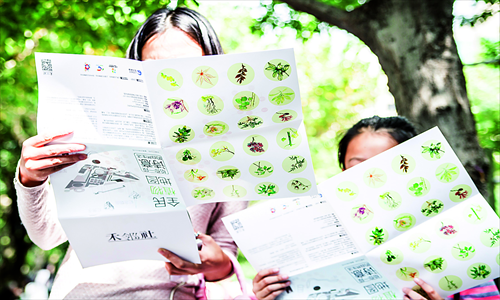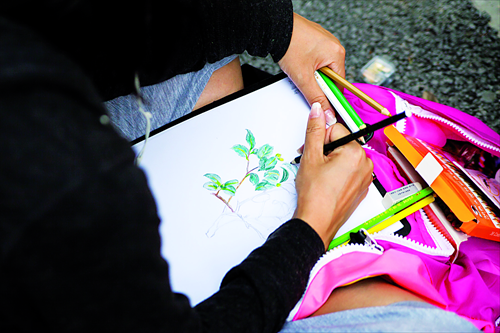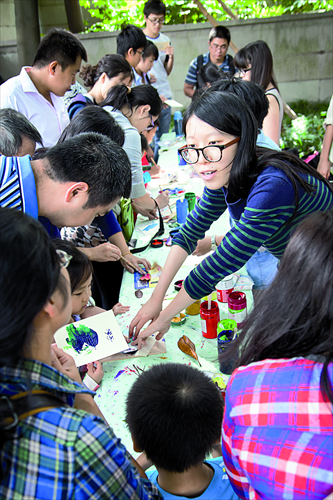Planting routes
Amateur artists get together to map out flora of city’s parks
On a warm autumn's Sunday beneath a big tree in Xujiahui Park, 27-year-old Gong Siwen covered a leaf with dark blue pigment before carefully pressing it against the cover of her notebook, leaving the imprint of a blue leaf.
"Leaves are very beautiful," Gong told the Global Times. She also showed off some leaves she had collected during a plant tour that morning organized by a local nonprofit art organization Helin Art in Community (HAC) as part of its Shanghai Flora Map Project.
Led by a plant expert and HAC volunteer, Gong strolled the park along with some 50 other local residents, many of whom were little kids. Each participant had a small flora map of the park made by HAC.
"This is a peach tree, and you can find a hand-painted picture of it on your flora map," said the guide. "Just as pine trees produce rosin, peach trees can produce gum. We call it 'peach gum.'"
Gong said the hour-long tour had been useful and fun, and that the tour guide had been very good. "We recognized and learned about more than 20 plants today," she said. "Each time we came across a tree or flower that was in the brochure, the guide would stop and tell us about it."

Local nonprofit art organization Helin Art in Community makes flora maps for major public parks in Shanghai. Photos: Courtesy of Cui Haobin

Grass roots
HAC started five years ago, when some art enthusiasts, including popular young artists and designers, established the organization and began holding nonprofit art activities in residential communities across the city. These activities included free performances and lectures.
They started the Shanghai Flora Map Project last autumn. It soon became popular, particularly among plant and painting lovers.
"Last year, we chose 10 main public parks in Shanghai, and made a flora map for each," Tian Xiaogeng, director of HAC, told the Global Times.
Most of the designated parks are located downtown, and include Xujiahui Park and Xiangyang Park in Xuhui district, and Jing'an Park in Jing'an district. "These parks are quite familiar to Shanghainese people, particularly the residents who live near them," said Tian.
Each flora map contains at least 60 paintings of plants that can be found in its respective park. "By recognizing, observing and drawing trees and flowers, people can learn more about the plants in our city, and thus embrace art within nature in a relatively simple way," said Tian.
Making the maps is no small task. The director of the project, Zhao Yueqiu, told the Global Times that to produce a flora map, HAC first invites a plant expert to visit the park in question and mark the locations of trees and flowers on the park's official map. The organization then recruits some 20 volunteers, who go to the park and paint the plants that the expert marked on the map.
HAC then selects which of these paintings to use. The map for Xujiahui Park, for instance, charted 111 plants in its 20-page colored booklet.
As well as having brief introductions, some plants, like the plum tree and pomegranate tree, are introduced through related classical Chinese poems.
Each map took around three months to complete. HAC invited local professional artists to design the covers of the 10 maps.
Works from the project by both volunteers and professional artists are to be exhibited at the Yuz Museum in Xuhui district from November 1 to 16. Entry will be free.

Branching out
After the plant tour in Xujiahui Park was over, participants learned to make prints with fallen leaves.
"Today my son and I learned about many trees and plants," said a mother surnamed Tang, as her 5-year-old son pressed a colored leaf onto a piece of card. "It's a very interesting and relaxing experience, and we enjoyed the beauty of nature a lot."
During the past year, HAC has held around 40 similar activities at 10 city parks, distributing some 10,000 flora maps to participants and surrounding residents.
Though he refused to give details of the costs involved, Tian said it was "not a small number" for a nonprofit organization, which is run by just seven people. "But luckily we have sponsors from local foundations and enterprises, and more importantly, our flora maps have been welcomed by thousands of people," he said. "I'm happy and confident about the project."